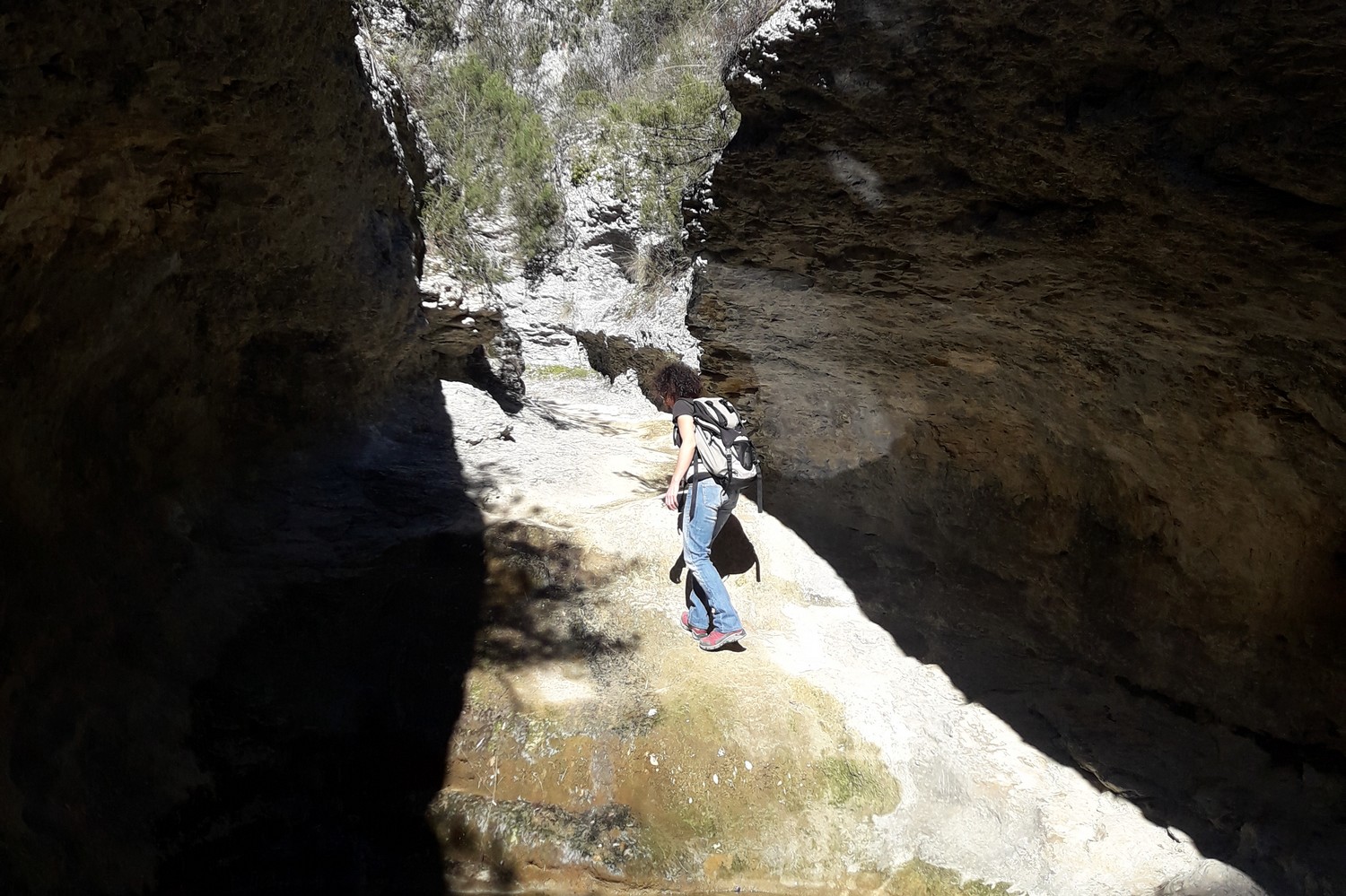
Veroncle, through its depths!
"Themastery of water and its uses is a dominant feature of Mediterranean civilization. If the gorgs of Veroncle, with its canals and windmills, are a striking proof of it, we too often forget the genius of which it was necessary to deploy and to exploit the water in our drymountains! " From "Mills of the Combe de Véroncle" OT of Gordes - Maurice Chabert, president of the departmental council of Vaucluse, formermayor of Gordes.
16 points of interest
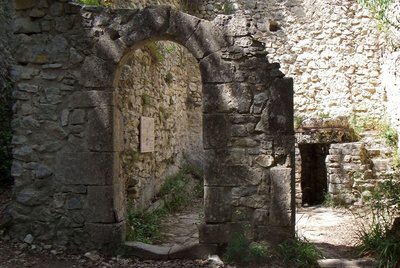
Moulin Cabrier - ©Eric Garnier - PNR Luberon  Patrimony and history
Patrimony and historyMoulin Cabrier
Dating most probably from the 16th century also, this milldid not have a dwelling unit. Given the modesty of the building, the hydraulic device upstream is spectacular. The pipe carved on the side of the rock comes out on a triangular well in ashlar stone. It is fed by a substantial resclause (small reservoir upstream) partly under rock. In 1874, the owner then built a dam across the Véroncle to increase his water reserves.

Fond des gorges de Véroncle - ©Eric Garnier - PNR Luberon  Geology
GeologyGorges de Véroncle
The water flow between the collapsed ditch of Murs located on the heights of the limestone plateau and the Apt basin downstream, dug this impressive canyon called "raccordement". Then the corrosive action of rain water containing carbon dioxide has gradually, through dissolution, enlarged cracks to create true underground networks. The Gorges de Véroncle are not used or hardly used by water, but contain an amazing industrial heritage.
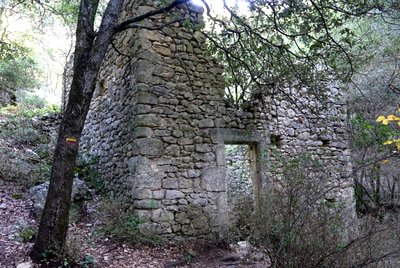
Moulin Jean de Marre II - ©Eric Garnier - PNR Luberon  Patrimony and history
Patrimony and historyJean de Marre II mill
This mill probably dates back to the 16th century. The building is simple in form: a water chamber partially collapsed and the grinding room above. Special feature of the site, the resclause (water supply) is quite far from the mill. Also, in order to emphasise the waterfall effect, a vertical well was used in way of the water chamber. Like all the mills of Gordes and unlike those of Murs, they did not belong to the Lord but to several private owners.
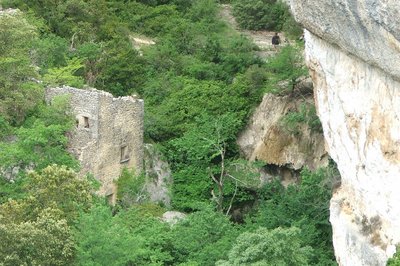
Moulin Jean de Marre I - ©Eric Garnier - PNR Luberon  Patrimony and history
Patrimony and historyJean de Marre I mill
It is the first mill of Gordes. Built in the 16th century, it was expanded in the 18th century, as evidenced by the collages of masonry. It is a more complex construction on 4 levels: the water chamber, the grinding room, the sack floor and the dwelling (you can still see a fireplace and a sink). In the 19th century, an independent farming developed with arable lands, vineyards, mulberry trees, olive trees, almond trees, pigs, chicken coops.

Cascade de tuf - ©Georges Guende - PNR Luberon  Flora
FloraThe tuff waterfall
The waterfall, where the Jean de Marre I mill was strategically located forms also a beautiful natural curiosity called tuff! Product of dissolved limestone redeposited, having captured plant and animal debris, the tuff is a very tender and friable rock. When the river is not dry, it is home to lush mosses and ferns particularly enjoying the saturated humidity of the place. This habitat is still rare and located in Provence.

Canon du moulin du puits de Cata - Jérémie Haye - PNR Luberon  Patrimony and history
Patrimony and historyMoulin du Puits de Cata
It is the fourth and last mill of Murs. It owes its name to an abyss probably belonging to the karst-hydraulic system of Monts-de-Vaucluse which feeds Fontaine-de-Vaucluse. From this mill, only the cannon cut into the rock remains and which carried a vertical wheel, which is quite unusual here. We can assume that this is not a flour mill for which an horizontal wheel is preferred; it was probably used for industrial purposes:: a grinder to sharpen.
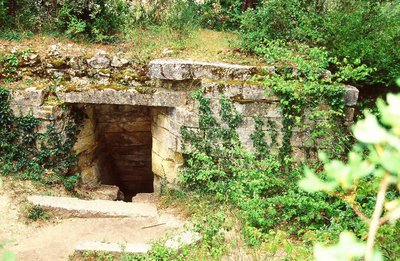
La canon en pierre de taille - Jérémie Haye - PNR Luberon  Patrimony and history
Patrimony and historyMoulin de la Charlesse
The third mill of the Gorges in Mursit is based on the same construction principle as the first two (a water chamber which is under the grinding room and the dwelling). The year 1753 is engraved on a stone corresponds most likely to the year of remodellingthan the initial construction. Here, we can easily distinguish the cannon in ashlar stone which allowed to create a waterfall and so a driving force between the resclause (small reservoir upstream) upstream and the water area below.
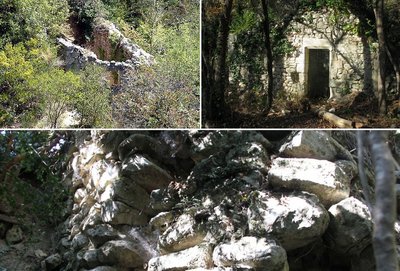
Vestiges du moulin du Dévissé - ©Eric Garnier - PNR Luberon  Patrimony and history
Patrimony and historyMoulin du Dévissé
It is the second mill of the Gorges in Murs. Also built in the 16th century as indicated by the year 1573 engraved on a stone from the entrance door, it is now in ruins. It was fed by a béal (channel) which is none other than a leak of the mill of the pond. Today, we can only make out the grinding room which is in flint. Below stood the water chamber today obstructed, and above, the dwelling of the miller.
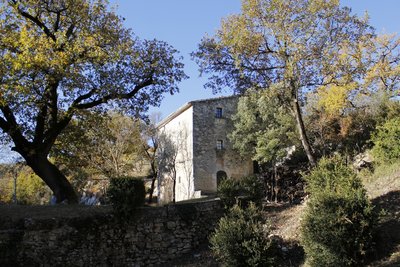
Moulin des étangs (habitation privée, ne se visite pas) - ©Jérémie Haye - PNR Luberon  Patrimony and history
Patrimony and historyMoulin de l'Etang
First mill of the Gorges and located on the lands of the Lord of Murs, the current building was probably built in the 16th century, as evidenced by the date 1581 on the lintel of a door. It was probably enlarged in the 18th century and more recently converted into a private housing. Initially, it operated with an horizontal wheel turned into a vertical wheel at the end of the 19th century. It was fed by a resclause (small reservoir upstream) located near the old pond.
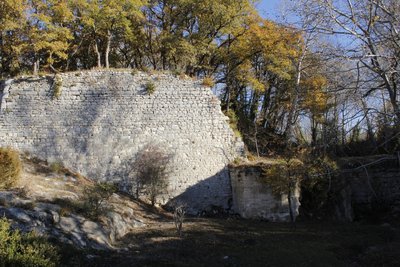
Ruines du barrage des étangs - ©Jérémie Haye - PNR Luberon  Patrimony and history
Patrimony and historyThe dam of the pond
Built in the 16th century, This large tank was used to supply the first three mills of the Gorges belonging to the Lord of Murs. It also served as a fishing reserve. Remodelled several times over the centuries, it no longer works nowadays but remains in place. Two parallel walls 80m long held back a pile of earth forming a earth-fill dam. On a quoin, we can see a badge dated 1584 which could be a date of remodelling of the building.

Genêt de Villars - Laurent Michel - PNR Luberon  Flora
FloraSmall garrigue (scrubland) in Genêt de Villars
On this arid hillside, you can see a discreet broom (shrub) against the ground: Villars broom (Genista pulchella subsp. villarsii). Its meagre look is an adjustment to sunny and dry environments: It sweats very little! While fearing competition from other species, he deigns to share its habitat with few neighbours hand-picked, like here, Perennials (Minuartia capillacea) family of carnations with beautiful white flowers.

Prairies humides de Murs - ©Jérome Brichard - PNR Luberon  Water and rivers
Water and riversGrasslands of Murs
Until the late 19th century, 15ha of natural hay meadows and pastures of this valley floor were partly submerged by the dam water feeding the mills of the Gorges. Today, these grasslands are wetlands, biodiversity supports, which fill the role of water storage, purification, protection against soil erosion and the run-off of the stream. They also have an important place in the local agricultural economy which is based on livestock.
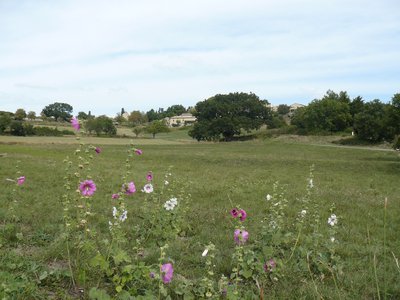
Début du fossé d'effondrement de Murs - Françoise Delville - PNR Luberon  Geology
GeologyThe ditch of Murs
The village of Murs dominates to the southwest a depression occupied by farmland. These grounds fit perfectly with the limestone and clay outcrops bordered by an imposing limestone mass. About 35 million years ago, during the Oligocene, deep fractures (faults) outlined a zone which sunk gradually: a Graben (german for ditch). This is the story of the ditch of Murs, which is also the story of Sénanque ...

Chaufferie bois-énergie de Murs - ©Hervé Vincent  Savoir-faire
Savoir-faireFirst wood fuel boiler of PACA
All of Remourase houses the very first collective energy wood boiler in the Luberon ... and even in the region! Established in 2000 during the redevelopment of a former holiday camp, it can heat 6 public housing, a lodge, a community hall and 5 local professionals. It is a renewable energy that contributes to the maintenance and the enhancement of the forest land. Since then, more than 40 boiler rooms of this type were carried out in Luberon.

Louis de Berton des Balbes dit Crillon le Brave - ©DR  Patrimony and history
Patrimony and historyCrillon le Brave, life of a warrior
At the heart of the village of Murs hides the birth house of Crillon le Brave, born in 1543. Born Louis de Berton des Balbes, he will then become Crillon and will continue to wage war. He accompanied 5 kings of France, Henri II, François II, Charles IX, the Duke of Anjou who became Henri III, and it was Henri IV, his comrade, who gave him the name Brave Crillon. His life was made of battles, wounds and victories. He died in 1615 in Avignon, a victim of his countless injuries.
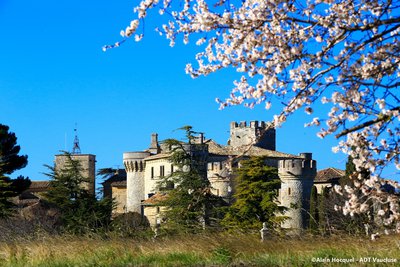
Château de Murs - ©Alain Hocquel - VPA  Patrimony and history
Patrimony and historyThe castle of Murs
It was around year 1.000 that the land of Murs is given to the Agoult family who will build a castle. For four centuries, it was mainly a stronghold for the soldiers of the lord and the dungeon was then built there. After the Agoult family, came the weapons of the Astouaud family which you can see on the castle gate. The church was built in a Romanesque style in the 12th century inside the castle. The building is private and therefore closed to the public.
Description
Before attacking the long ascent of the gorges, take the time to go and park a vehicle in the village of Murs to facilitate your return. Otherwise, return by the same path, or else by a part of the neighboring road "the integral of the gorge of Veroncle".
From the small car park on the edge of D2, go along the trail and join themill of the Grailles (private, can not be visited).
1 Go on the trail that leaves under the hamlet of the Grailles and, 60m further, take on the right the bottom of the ravine. Reach the Cabrier windmill. Slip along the wall on the left, cross a narrow passage in balcony, then pass the water supply channel. Weave along the wall to the left, cross a narrow balcony passage, then pass through the water carrying canal. Climb a first ladder, pass a ledge and continue alternating between the two banks. Higher up, cross a rocky ledge (handrail), then move left to rise. Pass a flat area and go down to the right. Go left to the bottom of the Gorges. Pass the Jean de Marre windmills (I and II) and then reach the crossroads upstream.
2 - Continue straight ahead for 30m. Leave on the right the path that goes up towards Murs and sneak straight into the bottom of the ravine. Stay on the right bank (left side ascends) and find themill of the Well of Cata. Ascend to the left to pass the offset and continue upstream of the gorge. Join the foot of the Charlessemill. Climb left to reach the entrance of its forced pipe.
3 - Turn right and continue along the trail in the bottom of the valley. Pass the Devissé windmill and continue going. Go past themill of the ponds (private, can not be visited) and before the ruins of the dam, climb two winding paths on the right. At the end of the trail, continue straight ahead. Farther, go up the small road on the right and reach the village of Murs.
- Departure : Hameau des Grailles, foot of the gorge of Véroncle, Gordes
- Arrival : Village of Murs, at the top of the gorge of Véroncle
- Towns crossed : Gordes and Murs
Forecast
Altimetric profile
Recommandations
Do not go after a thunderstorm or in rainy weather; certain passages in the bottom of the ravine can prove to be very delicate or even dangerous!
In the downstream part of the gorge, be very careful on the crossings ofmore or less aerial offsets (ladder, handrail).
Caution with your ankles on rocky and slippery passages at the bottom.
Information desks
House of the Luberon Regional Nature Park
60, place Jean Jaurès, 84400 Apt
In the heart the old town centre of Apt, the House of the Luberon Regional Nature Park welcomes you in a town house of the 18th century. The permanent exhibition of the geology museum has a rich collection of fossils evidencing the geological history of the Luberon.
On sale at the shop: books, maps, guidebooks, games, posters...
Open Monday to Friday from 8:30 am to 12:00 pm and from 1:30 pm to 6 pm (and on Saturday, depending on the program). Free admission.
OTI Luberon Coeur de Provence
Place François Tourel, 84300 Cavaillon
OTI Pays d’Apt Luberon
788 avenue Victor Hugo, 84400 Apt
Du 1er avril au 30 septembre
Ouvert du lundi au samedi de 9h30 à 12h30 et de 14h à 18h.
Juillet et août : Ouvert dimanche et jours fériés de 9h30 à 12h30
Du 1er octobre au 31 mars
Ouvert du lundi au mardi et du jeudi au samedi de 9h30 à 12h30 et de 14h à 18h.
Fermé le mercredi, dimanche et jours fériés.
Access and parking
20km northeast of Cavaillon, by the D2
Parking :
More information
Report a problem or an error
If you have found an error on this page or if you have noticed any problems during your hike, please report them to us here:



